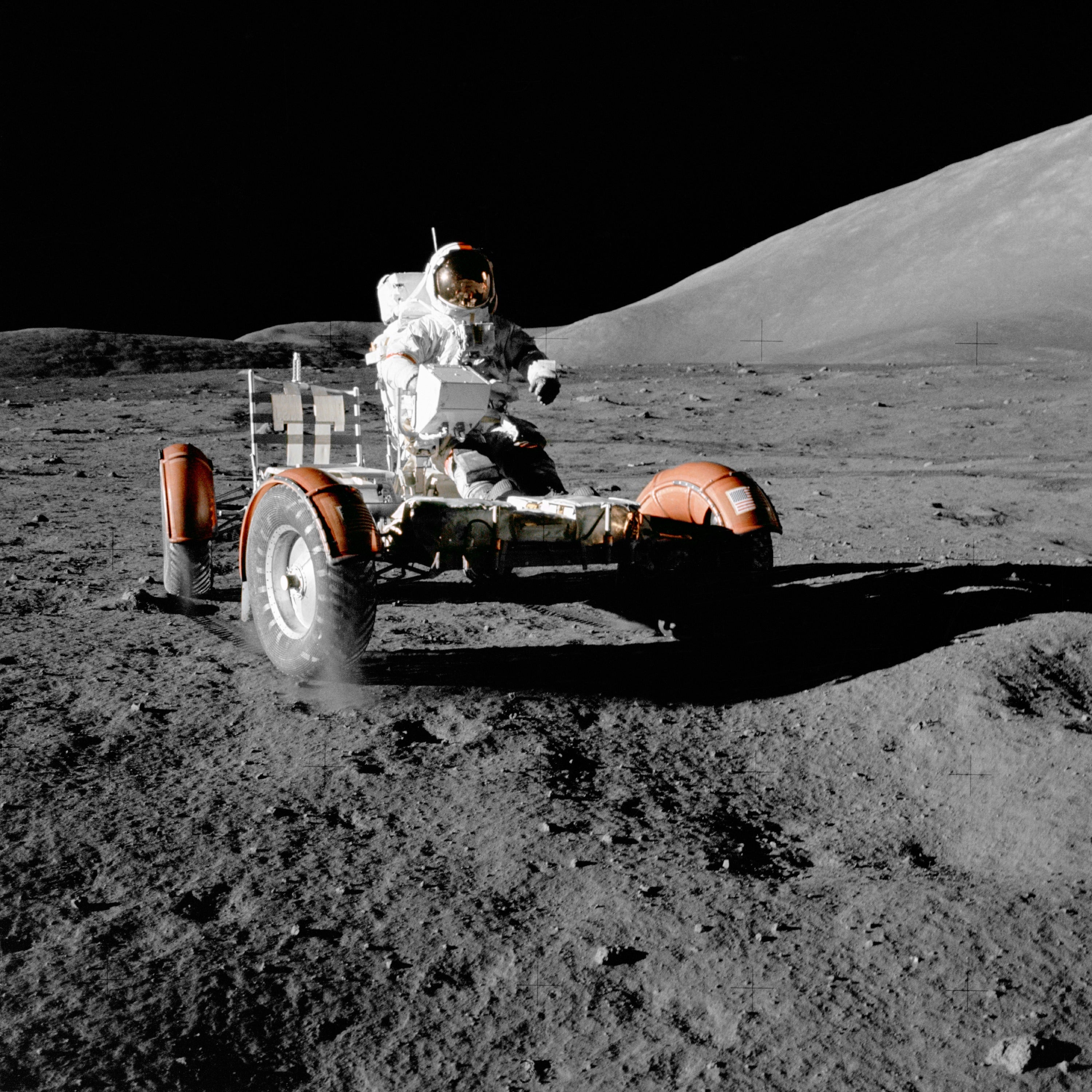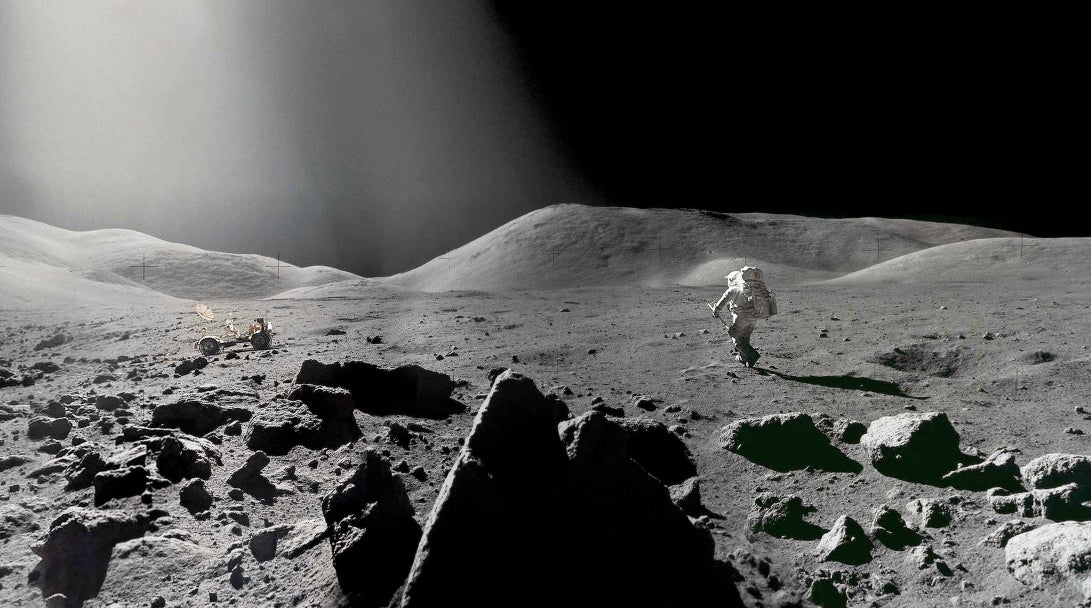On
December 11, 1972, Apollo 17 touched down on the Moon. This was not
only our final Moon landing, but the last time we left Low Earth Orbit.
With the successful launch of the Orion capsule, NASA is finally poised
to go further again. So it's important to remember how we got to the
Moon — and why we stopped going.
Crewed by
Commander Eugene A. Cernan, Command Module Pilot Ronald E. Evans and
Lunar Module Pilot Harrison P. Schmitt, the Apollo 17 mission was the
first to include a scientist. The primary scientific
objectives
included "geological surveying and sampling of materials and surface
features in a preselected area of the Taurus-Littrow region; deploying
and activating surface experiments; and conducting in-flight experiments
and photographic tasks during lunar orbit and transearth coast."
Harrison
'Jack' Schmidt had earned his PhD in Geology from Harvard University in
1964, and had worked for the United States Geological Survey and at
Harvard University before going through Astronaut training in 1965.
Apollo 17 was his first mission into space, and would be the first
astronaut-scientist to step on the surface of the Moon. Accompanying him
was Eugene 'Gene' Cernan, a veteran astronaut who had first flown into
space with the Gemini IX-A mission in 1966 and later served as the Lunar
Module Pilot for the Apollo 10 mission in May of 1969, where he came
within 90 miles of the Lunar surface.
04 14 21 43: Schmidt: Stand by. 25 feet, down at 2. Fuel's good. 20 feet. Going down at 2. 10 feet. 10 feet -
04 14 21 58: Schmidt: CONTACT.
04 14 22 03: Schmidt: *** op, push. Engine stop; ENGINE ARM; PROCEED; COMMAND override, OFF; MODE CONTROL, ATT HOLD; PGNS, AUTO.
Schmidt
landed the Challenger Lunar Module in the Taurus-Littrow lunar valley,
just to the southeast of Mare Serenitatis, a region of geological
significance on the Moon. The mission's planners hoped that the region
would provide a wealth of information about the history of the Moon's
surface. Upon landing, the pair began their own observations of the
lunar surface:
04
14 37 05: Cernan: "You know, I noticed there's even a lot of difference
in earthshine and - and in the double umbra. You get in earthshine on
the thing, and it's - it's hard to see the stars even if you don't have
the Earth in there."
04 14 23 28: Cernan: "Oh, man. Look at that rock out there."
Schmidt: "Absolutely incredible. Absolutely incredible."
After several hours of preparation, Cernan stepped onto the Lunar surface:
04
18 31 0: "I'm on the footpad. And, Houston, as I step off at the
surface at Taurus-Littrow, I'd like to dedicate the first step of Apollo
17 to all those who made it possible. Jack, I'm out here. Oh, my golly.
Unbelievable. Unbelievable, but is it bright in the Sun. Okay. We
landed in a very shallow depression. That's why we've got a slight
pitch-up angle. Very shallow, dinner-plate-like."
The two
astronauts unloaded a lunar rover, and began to deploy scientific
instruments around their landing site: an experiments package and
explosives (to complete seismic experiments begun with other Apollo
missions in other locations on the Moon). Their first exclusion in the
rover yielded numerous samples of lunar rock. Over the next couple of
days, the astronauts completed two additional Moon walks, where they
continued to drive across the lunar surface and collect samples.
Schmidt
later described the landing site to NASA Oral historian Carol Butler:
"It was the most highly varied site of any of the Apollo sites. It was
specifically picked to be that. We had three-dimensions to look at with
the mountains, to sample. You had the Mare basalts in the floor and the
highlands in the mountain walls. We also had this apparent young
volcanic material that had been seen on the photographs and wasn't
immediate obvious, but ultimately we found in the form of the orange
soil at Shorty crater."
Why we went to space
The
scientific endeavors of Apollo 17 were the culmination of a massive
program that had begun in 1963 following the successes of the Mercury
Program. In the aftermath of the Second World War, the United States and
Soviet Union became embroiled in a competitive arms race that saw
significant military gains on both sides, eventually culminating in the
development of rockets capable of striking enemy territory across the
world. The next step for arms superiority jumped from the atmosphere to
Low Earth Orbit to the Moon, the ultimate high ground. As this happened,
each country capitalized on the advances in rocket technology to
experiment with human spaceflight missions. The Soviet Union succeeded
in putting Yuri Gagarin into space in 1961, just a couple of years after
launching the first satellite into orbit.
Closely
followed by the United States, space became an incredibly public
demonstration of military and technological might. The development of
space travel didn't occur in a political vacuum: the drive for the
United States to develop rockets and vehicles which could travel higher
and faster than their Soviet counterparts happened alongside increasing
US/USSR tensions, especially as geopolitical crises such the Cuban
Missile Crisis and the US deployment of missiles to Turkey demonstrated
how ready each country was to annihilating the other.
As the
space program took off, it was supported by other research and
scientific efforts from the broader military industrial complex which
President Dwight Eisenhower had worried about just a handful of years
earlier. (Eisenhower had not been a major supporter of the development
of space travel which began under his watch, and had attempted to
downplay the significance of Sputnik.) The red hot environment of the
Cold War allowed for significant political capital and governmental
spending which supported a first-strike infrastructure, and in part,
trickled over to the scientific and aeronautical fields, which
maintained a peaceful and optimistic message.
By 1966,
the space race peaked: NASA received its highest budget ever, at just
under 4.5% of the total US federal budget, at $5.933 billion dollars
(around $43 billion today.) The United States had made clear gains in
space by this point: Project Gemini had completed its final mission, and
with efforts towards the next phase under Apollo were well under way.
By this point, the social and political infrastructure and support for
space had begun to wane, and would ultimately fall away after Apollo 11
successfully landed on the Moon's surface in July of 1969. After this
point, NASA continued with planned missions, and eventually landed five
additional Apollo missions on the Moon. (Another, Apollo 13, was unable
to land after mechanical problems).
Changing priorities
Just a year
after Apollo 11 landed, NASA began to reprioritize: plans for a space
station were revived, and in 1970, they announced that Apollo 20 would
be cancelled in favor of the creation of a new venture: Skylab. On
September 2nd, 1970, the agency announced the final three Apollo
missions: Apollo 15, 16 and 17. The agency was forced to contend with
political pressure as well: In 1971, the White House intended to
completely cancel the Apollo program after Apollo 15, but ultimately,
the two remaining Apollo missions were kept in place. Harrison Schmidt,
who had been training for Apollo 18, was bumped up to Apollo 17 after
NASA faced pressure from scientists to send one of their own to the
Moon.
On December 14th, 1972, Cernan became the last human to step on the Moon's surface:
07
00 00 47: "Bob, this is Gene, and I'm on the surface and as I take
man's last steps from the surface, back home, for some time to come, but
we believe not too long into the future. I'd like to Just list what I
believe history will record that America's challenge of today has forged
man's destiny of tomorrow. And, as we leave the Moon at Taurus Littrow,
we leave as we come and, God willing, as we shall return, with peace
and hope for all mankind. Godspeed the crew of Apollo 17."
In the
forty-two years since those words were spoken, nobody has stepped on the
Moon. The levels of federal spending which NASA had received before
1966 had become untenable to a public which had become financially wary,
particularly as they experienced a major oil crisis in 1973, which
shifted the nation's priorities. Spending in space was something that
could be done, but with far more fiscal constraints than ever before,
limiting NASA to research and scientific missions in the coming years.
Such programs included the development of the Skylab program in 1973,
and the Space Shuttle program, as well as a number of robotic probes and
satellites.
This shift
in priorities deeply impacted the willpower of policymakers to implement
new exploratory missions to the Moon and beyond. Optimistic dreams of
reaching Mars had long since perished, and as NASA focused on the Space
Shuttle, the physical infrastructure which supported lunar missions
vanished: No longer were Saturn V rockets manufactured, and unused
rockets were turned into museum displays. The entire technical and
manufacturing apparatus, which has supported both military and civilian
operations, had likewise begun to wind down. The Strategic Arms
Limitation Talks (SALT) and its successors began to freeze the numbers
of missiles which could be deployed by both the United States and Soviet
Union in 1972, and each country largely began to step down their
operations. The urgency which fueled the Cold War arms race had begun to
cool, and along with it, the support for much of the efforts required
to bring people into space and to the Moon.
Since that
time, US Presidents have spoken of their desire to return to the Moon,
but often in terms of decades, rather than in single digits. It's easy
to see why: up until recently, US spaceflight operations were focused
entirely on Low Earth Orbit activities, as well as admirable cooperative
international programs such as the International Space Station, and
major scientific instruments such as Mars Pathfinder, Opportunity/Spirit
and Curiosity. Other major concerns have redirected US attentions from
spaceflight: the United States' War on Terror, which is expected to cost
US taxpayers over $5 trillion dollars in the long run.
The launch
of Orion atop a Delta IV Heavy rocket was exciting to watch, as well as
newer players in the space launch field, SpaceX and Orbital Sciences
Corporation, which suggesting that a new generation of infrastructure is
being constructed. The reasons for visiting the Moon and potentially,
other planets and bodies in our solar system, are numerous: they could
be the greatest scientific endeavors of our existence, allowing us to
further understand the creation of our planet and solar system and the
greater world around us. More importantly though, such missions
contribute to the character of the nation, demonstrating the importance
of science and technology to our civilization, which will ultimately
help us process and address the issues of greatest concern: the health
of our planet. Hopefully, Cernan's words and hope that our absence from
the Moon will be short-lived, and that we will once again explore new
worlds in our lifetimes.



















